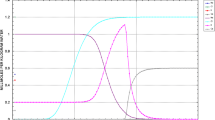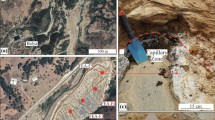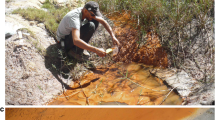Abstract
Estimation of the long-term environmental impact of mining wastes is of socio-economic interest. Bulk analytical approaches of the neutralizing (NP) and acid potentials (AP) provide in general worst-case scenarios for acid rock drainage (ARD) predictions and long-term evaluation. Taking individual graded layers with variable reactive mineral ratios into consideration, alternating zones, highly contrasting in their neutralizing and acid potential, can be identified and quantified using scanning electron microscope–mineral liberation analyzer (SEM–MLA) and μ-energy-dispersive X-ray fluorescence (EDXRF)–petrographic analyst (PA) for the first time. The bulk NP and AP values increased by a factor of 2.13 and 1.37, respectively, compared to the average values of the mineralogical NP/AP. At the contrasting boundaries, precipitation of pore-clogging secondary phases might be enhanced. These new information can be used as input parameters to model the future behavior of a non-homogeneous multiplied laminated body with reactive transport modeling.




Similar content being viewed by others
References
Blowes DW, Al T, Lortie L, Gould WD, Jambor JL (1995) Microbiological, chemical and mineralogical characterization of the Kidd Creek mine tailings impoundment, Timmins area, Ontario. Geomicrobiol J 13:13–31
Courtin-Nomade A, Grosbois C, Marcus MA, Fakra SC, Beny J-M, Foster AL (2009) The weathering of a sulfide orebody: speciation and fate of some potential contaminants. Can Mineral 47:493–508
Dobbe R, Gottlieb P, Gu Y, Butcher AR, Fandrich R, Lemmens H (2009) Scanning electron beam-based automated mineralogy-outline of technology and selected applications in the Natural Resources Industry. In: EMAS 2009. 11th European Workshop on Modern Development and Applications in Microbeam Analysis, Gdynia/Rumia, Gdansk, Poland; 10-14 May 2009, p 169–189
Dold B (2003) Speciation of the most soluble phases in a sequential extraction procedure adapted for geochemical studies of copper sulfide mine waste. J Geochem Explor 80:55–68
Fandrich R, Gu Y, Burrows D, Moeller K (2007) Modern SEM-based mineral liberation analysis. Int J Miner Process 84:310–320
Hageman PL, Seal RR, Diehl SF, Piatak NM, Lowers HA (2015) Evaluation of selected static methods used to estimate element mobility, acid-generating and acid-neutralizing potentials associated with geologically diverse mining wastes. Appl Geochem 57:125–139
Johnson RH, Blowes DW, Robertson WD, Jambor JL (2000) The hydrogeochemistry of the Nickel Rim mine tailings impoundment, Sudbury, Ontario. J Contam Hydrol 41:49–80
Lawrence RW, Scheske M (1997) A method to calculate the neutralization potential of mining wastes. Environ Geol 32:100–106
Lawrence RW, Wang Y (1997) Determination of neutralization potential for acid rock drainage prediction. MEND/NEDEM Report 1.16.3 (Canadian Centre for Mineral and Energy Technology, Ottawa), p 149
Lichtner P (2007) FLOTRAN user’s manual: two-phase nonisothermal coupled thermal hydrologic-chemical (THC) reactive flow & transport code, version 2.0. Los Alamos, USA. LANL Report LA-UR-01–2349
Lottermoser B (2010) Mine wastes. Characterization, treatment and environmental impacts. Springer, Berlin, 400p
Meima JA, Redwan M, Rammlmair D (2011) Application of MLA in reactive transport modeling of weathering processes in intensely stratified tailings. In: 19th IASTED International conference on applied simulation and modeling (ASM 2011), 22–24 June 2011, Crete, Greece. doi: 10.2316/P.2011.715-030
Meima JA, Graupner T, Rammlmair D (2012) Modeling the effect of stratification on cemented layer formation in sulfide-bearing mine tailings. Appl Geochem 27:124–137
Nieto JM, Sarmiento AM, Olías M, Canovas CR, Riba I, Kalman J, Delvalls TA (2007) Acid mine drainage pollution in the Tinto and Odiel rivers (Iberian Pyrite Belt, SW Spain) and bioavailability of the transported metals to the Huelva Estuary. Environ Int 33:445–455
Nikonow W, Rammlmair D (2014) Calculation of diffraction free spectra using a double-detector µ-EDXRF system, In: Chetty D, Andrews L, Villiers Jd, Dixon R, Nex P, Reimold WU, Richards J, Smith B, Smith C, Verryn S, Viljoen F (eds), 21st General Meeting of IMA. A joint publication of the Geological Society of South Africa and the Mineralogical Association of South Africa, Johannesburg, South Africa, p 311
Nikonow W, Rammlmair D (2015) Spatially-resolved energy dispersive X-ray fluorescence analysis combined with automated image analysis. In: 12th International congress for applied mineralogy (ICAM 2015), 10–12 August 2015, Istanbul, Turkey
Nikonow W, Rammlmair D (2016) Risk and benefit of diffraction in Energy Dispersive X-ray fluorescence mapping. Spectrochim Acta Part B: At Spectrosc 125:120–126
Paktunc D (1999) Characterization of mine wastes for prediction of acid mine drainage. In: Azcue JM (ed) Environmental impacts of mining activities. Springer, Berlin, pp 19–38
Price WA, Errington J (1994) ARD policy for mine sites in British Columbia. In: Proceedings of the international land reclamation and mine drainage conference. USBM SP 06A-94, NTIS, Springfield, VA, pp 285–293
Rammlmair D, Grissemann Ch (2000) Natural Attenuation in slag heaps versus remediation. In: Rammlmair D, Mederer J, Oberthür Th, Heimann RB, Pentinghaus H, (eds). Applied mineralogy in research, economy, technology, ecology and culture. In: Proceedings 6th International Congress on Applied Mineralogy, ICAM 2000, Göttingen, Germany, 17–19 July 2000, 2, 645–648
Rammlmair D, Nikonow W (2016) Risk and benefit of diffraction in X-ray fluorescence mapping (μ-EDXRF). Spectrochim Acta Part B 125:120–126
Rammlmair D, Grissemann Ch, Graupner T, Meima JA, Romero Baena A (2008) Acid mine drainage remediation starts at the source. Macla - Revista de la Sociedad Espanola de Mineralogia 10:29–33
Redwan M, Rammlmair D, Meima JA (2012) Application of mineral liberation analysis in studying micro-sedimentological structures within sulfide mine tailings and their effect on hardpan formation. Sci Total Environ 414:480–493
Sima M, Dold B, Frei L, Senila M, Balteanu D, Zobriste J (2011) Sulfide oxidation and acid mine drainage formation within two active tailings impoundments in the Golden Quadrangle of the Apuseni Mountains, Romania. J Hazard Mater 189:624–639
Sobek AA, Schuller WA, Freeman JR, Smith RM (1978) Field and laboratory methods applicable to overburdens and mine soils. EPA-600/2-78-054 (U.S. Environmental Protection Agency Cincinnati, Ohio)
Steefel CI, DePaolo DJ, Lichtner PC (2005) Reactive transport modeling: an essential tool and a new research approach for the Earth sciences. Earth Planet Sci Lett 240:539–558
Wilkin RT (2007) Metal attenuation processes at mining sites. U.S. Environmental Protection Agency, EPA/600/R-07/092
Xu T, Sonnenthal E, Spycher N, Pruess K (2004) TOUGHREACT user’s guide: a simulation program for nonisothermal multiphase reactive geochemical transport in variably saturated geologic media. Lawrence Berkeley National Laboratory, Berkeley, p 192
Acknowledgements
The authors gratefully acknowledge the DAAD [Programme/-ID: Research Stays for University Academics and Scientists, 2015 (50015559)] to finance the first author. This work was logistically supported by BGR. The authors gratefully acknowledge Dominic Göricke (BGR) for helping in the analytical work. We thank the reviewers for their constructive comments and suggestions that have significantly improved earlier versions of the manuscript.
Author information
Authors and Affiliations
Corresponding author
Rights and permissions
About this article
Cite this article
Redwan, M., Rammlmair, D. & Nikonow, W. Application of quantitative mineralogy on the neutralization–acid potential calculations within µm-scale stratified mine tailings. Environ Earth Sci 76, 46 (2017). https://doi.org/10.1007/s12665-016-6344-4
Received:
Accepted:
Published:
DOI: https://doi.org/10.1007/s12665-016-6344-4




